show me the money
DOE announces over $60M in federal funding for power grid improvement

The United States Department of Energy is doling out over $200 million for grid improvements — and one of the largest portions will be coming to Texas. Photo via Getty Images
Texas is getting $60.6 million in federal grants to bolster the state’s frequently taxed power grid.
The funding, announced July 6 by the U.S. Department of Energy, totals over $200 million to be distributed across the country. The Lone Star State's chunk will be earmarked for pinpointing gaps in the grid’s dependability and reducing weather-related grid disruptions. The Texas Division of Energy Management will decide how to dole out the money.
“By itself, is $60 million going to be determinative to make our grid reliable? Of course not,” Doug Lewin, president of Austin-based energy consulting firm Stoic Energy, tells the Austin American-Statesman. “It’ll cost more than that, but every bit counts, and $60 million is not a small amount of money, so [the state] could probably do a lot of good with that.”
The Texas grid infamously came under intense scrutiny in February 2021 during and after the statewide deep freeze. The cold snap caused power plants and natural gas facilities to fail, leading to blackouts around the state and at least 200 deaths.
The February 2021 disaster “exposed the inability of the state’s energy supply chain to withstand extremely cold temperatures,” the Federal Reserve Bank of Dallas observes. The bank adds that “questions remain whether the electrical grid is now more resilient to winter weather.”
Although the grid has held up during this year’s heat wave, some observers wonder how long the grid can handle record-setting demand and still keep the lights (and air conditioning) on. So far, an abundance of wind and solar power has rescued Texas from the same fate that crippled the state in February 2021.
All eyes then and now are on the quasi-governmental Electric Reliability Council of Texas (ERCOT), which delivers power to about 90 percent of the state.
Since ERCOT’s winter debacle two years ago, state officials have beefed up weatherization requirements for power generation, power transmission, and natural gas facilities. Meanwhile, ERCOT underwent a management overhaul and bumped up its backup supply of thermal power.
During the state legislative session in 2021, a measure that would have earmarked $2 billion for weatherization of Texas power facilities passed in the House but stalled in the Senate.
This year, Texas lawmakers created a fund containing as much as $10 billion for loans and grants to encourage construction and maintenance of gas-fueled power plants. Gov. Greg Abbott signed that bill. But separate legislation that would have set aside billions of dollars to build a network of gas-powered backup plants died in the House.
A report published in 2022 by Rice University’s Baker Institute for Public Policy faulted ERCOT for the previous year’s winter chaos but didn’t pin sole blame on the organization. The report recommended better coordination among state regulators regarding the power grid, including potential formation of a state agency dedicated solely to energy issues. Today, the Texas Railroad Commission and Public Utility Commission of Texas largely share oversight of energy matters in the state.
“All forms of generation capacity experienced failures,” says the institute’s report on the 2021 winter catastrophe, “but bureaucratic failure in identifying and addressing risks along fuel supply chains was a major failure.”